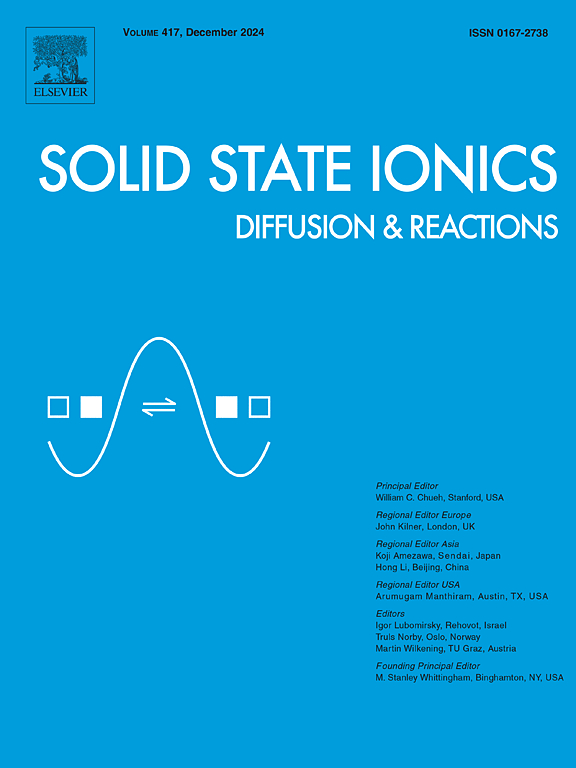Cation disorder and lithium conductivity in mechanochemically synthesized chloride solid electrolytes
IF 3.3
4区 材料科学
Q3 CHEMISTRY, PHYSICAL
引用次数: 0
Abstract
Developing fast, stable, and scalable Li conductors is crucial for advancing all-solid-state batteries (ASSBs). Here, we present a rapid, one-hour mechanochemical synthesis of chloride electrolytes Li2BxCl4 (B = Zn, Mg, Zr and x = 1 and 2/3) via high-energy ball milling (HEBM), achieving the targeted spinel phase without the need for any annealing steps. In Li2ZnCl4 electrochemical impedance spectroscopy reveals an unexpected, reversible low-temperature ionic transition at ∼75 °C, leading to a dramatic increase in total Li+ conductivity, from 2.95·10−9 S·cm−1 at 25 °C to an extrapolated room temperature conductivity of 3.24·10−5 S·cm−1 following heating to 125 °C. To elucidate the structural origins of this transition, we employ neutron powder diffraction (NPD), variable-temperature powder X-ray diffraction (PXRD), differential scanning calorimetry (DSC), and 6Li MAS NMR spectroscopy. We explore the stabilization of the high conducting phase via the introduction of host cation vacancies and therefore increasing the Li/B ratio based on the spinel-related compounds, Li2Zn1/3Zr1/3Cl4 and Li2Mg1/3Zr1/3Cl4, synthesized via the same one-hour mechanochemical approach. Rietveld refinement of NPD data reveals a monoclinic lattice distortion and cation disorder in both compounds, which open new Li conduction pathways. In both materials, 2–4 orders of magnitude increase of conductivity is achieved by aliovalent Zr4+-substitution compared to the undoped counterparts Li2ZnCl4 and Li2MgCl4, leading to maximum bulk conductivities up to 10−4 S·cm−1 at room temperature. Notably, the investigated chloride-based solid electrolytes consist of non-critical elements and exhibit high thermal stability up to at least 190 °C which can be key for easy scalable processing. These results highlight the potential of spinel-based chloride electrolytes as candidates for next-generation solid-state battery applications, combining rapid and scalable synthesis with promising ionic transport properties.
机械化学合成氯化物固体电解质中的阳离子无序性和锂电导率
开发快速、稳定、可扩展的锂导体对于推进全固态电池(assb)至关重要。在这里,我们通过高能球磨(HEBM)快速,1小时的机械化学合成氯电解质Li2BxCl4 (B = Zn, Mg, Zr和x = 1和2/3),无需任何退火步骤即可获得目标尖晶石相。在Li2ZnCl4中,电化学阻抗谱揭示了一个意想不到的,可逆的低温离子转变,导致Li+的总电导率急剧增加,从25°C时的2.95·10−9 S·cm−1到加热到125°C时的外推室温电导率为3.24·10−5 S·cm−1。为了阐明这种转变的结构来源,我们采用了中子粉末衍射(NPD)、变温粉末x射线衍射(PXRD)、差示扫描量热法(DSC)和6Li MAS NMR波谱。我们通过同样的1小时机械化学方法合成尖晶石相关化合物Li2Zn1/3Zr1/3Cl4和Li2Mg1/3Zr1/3Cl4,探索了通过引入主阳离子空位来稳定高导电相,从而提高Li/B比的方法。NPD数据的Rietveld细化揭示了这两种化合物的单斜晶格畸变和阳离子无序,开辟了新的锂传导途径。在这两种材料中,与未掺杂的Li2ZnCl4和Li2MgCl4相比,通过价Zr4+取代,电导率提高了2-4个数量级,导致室温下的最大体电导率高达10−4 S·cm−1。值得注意的是,所研究的氯化物基固体电解质由非关键元素组成,并表现出高达至少190°C的高热稳定性,这是易于扩展加工的关键。这些结果突出了尖晶石基氯化物电解质作为下一代固态电池应用的候选材料的潜力,结合了快速、可扩展的合成和有前途的离子传输特性。
本文章由计算机程序翻译,如有差异,请以英文原文为准。
求助全文
约1分钟内获得全文
求助全文
来源期刊

Solid State Ionics
物理-物理:凝聚态物理
CiteScore
6.10
自引率
3.10%
发文量
152
审稿时长
58 days
期刊介绍:
This interdisciplinary journal is devoted to the physics, chemistry and materials science of diffusion, mass transport, and reactivity of solids. The major part of each issue is devoted to articles on:
(i) physics and chemistry of defects in solids;
(ii) reactions in and on solids, e.g. intercalation, corrosion, oxidation, sintering;
(iii) ion transport measurements, mechanisms and theory;
(iv) solid state electrochemistry;
(v) ionically-electronically mixed conducting solids.
Related technological applications are also included, provided their characteristics are interpreted in terms of the basic solid state properties.
Review papers and relevant symposium proceedings are welcome.
 求助内容:
求助内容: 应助结果提醒方式:
应助结果提醒方式:


